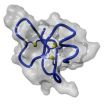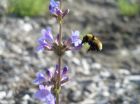(Press-News.org) Under standard laboratory conditions, the human beta-defensin 1 (hBD-1), a human antibiotic naturally produced in the body, had always shown only little activity against microbes. Nevertheless the human body produces it in remarkable quantities. The solution to the puzzle was the investigation process itself, as the research group led by Dr. Jan Wehkamp at the Dr. Margarete Fischer-Bosch Institute for Clinical Pharmacology of the Stuttgart-based Robert Bosch Hospital found out.
Before the research group took a new approach to this research, defensins were usually tested in the presence of oxygen, although little oxygen is present, for example, in the human intestine. Starting out from the discovery that a special antibiotic-activating protein of the human body is diminished in patients with inflammatory bowel diseases, Crohn's Disease and Ulcerative Colitis, the working group investigated how defensins act under low-oxygen conditions. During their investigations the scientists found out that under these conditions hBD-1 unfolds a strong antibiotic activity against lactic acid bacteria and yeast.
Furthermore the researchers discovered that another human protein, thioredoxin, is able to activate beta-defensin 1 even in the presence of oxygen. Moritz Marcinowski and Professor Johannes Buchner from the Department of Chemistry at the Technical University of Munich, used circular dichroism spectroscopy to elucidate the differences between the folded inactive and the unfolded active form of the protein.
Surprisingly, while almost all proteins are active only in their folded form, in the case of the small defensin the opposite is true. To activate the beta-defensin 1 the thioredoxin opens the three disulphide bridges that hold the molecule together. The molecule then opens up into the active state. Using this mechanism the body has the opportunity to selectively activate the defensin.
So far the cause of inflammatory bowel disease is unclear. Genetic as well as environmental factors seem to play a role, finally leading to a weakening of the antimicrobial barrier, which is mainly mediated by defensins. Accordingly the identified mechanism might contribute to the development of new therapies to treat affected patients.
INFORMATION:
The presented work is the result of a cooperation project with six participating centers, led by Emmy Noether junior research group leader Dr. Jan Wehkamp. In addition to five researchers from Stuttgart (Dr. Margarete Fischer-Bosch-Institute for Clinical Pharmacology and the Robert Bosch-Hospital (Bjoern Schroeder, Sabine Nuding, Julia Beisner, Eduard Stange and Jan Wehkamp) the Department of Dermatology at University of Tübingen (Martin Schaller), the Max-Planck-Institute for Developmental Biology in Tübingen (Sandra Groscurth), the Department of Dermatology at University of Kiel (Zhihong Wu), as well as the Department of Chemistry at the Technische Universitaet Muenchen (Moritz Marcinowski and Johannes Buchner) were involved. The work was funded by the Deutsche Forschungsgemeinschaft (Emmy Noether-Program for young researchers, Cluster of Excellence Center for Integrated Protein Science Munich) and by the Robert- Bosch-Foundation.
Original publication:
„Reduction of disulfide bonds unmasks potent antimicrobial activity of human β-defensin 1", B.O. Schroeder, Z. Wu, S. Nuding, S. Groscurth, M. Marcinowski, J. Beisner, J. Buchner, M. Schaller, E.F. Stange, J. Wehkamp, Nature, DOI: 10.1038/nature09674
Defense mechanism against bacteria and fungi deciphered
Mystery of 'inactive' defensin solved
2011-01-22
ELSE PRESS RELEASES FROM THIS DATE:
NFL linemen recover from back surgery, and so can you
2011-01-22
CHICAGO --- If NFL linemen can recover from back surgery and return to their spine-bruising careers, so can you get back into your "game" of horsing around with your kids or working out at the gym after back surgery.
That's the good news from a new Northwestern Medicine study that found 80 percent of NFL lineman – whose spines are especially vulnerable to degeneration – were able to return to play many more games after the surgery. These elite athletes spend a lot of time in a squatting stance that puts tremendous stress on their spine.
The study is encouraging ...
Mindfulness meditation training changes brain structure in 8 weeks
2011-01-22
Participating in an 8-week mindfulness meditation program appears to make measurable changes in brain regions associated with memory, sense of self, empathy and stress. In a study that will appear in the January 30 issue of Psychiatry Research: Neuroimaging, a team led by Massachusetts General Hospital (MGH) researchers report the results of their study, the first to document meditation-produced changes over time in the brain's grey matter.
"Although the practice of meditation is associated with a sense of peacefulness and physical relaxation, practitioners have long ...
Islands in the sky: How isolated are mountain top plant populations?
2011-01-22
Do mountain tops act as sky islands for species that live at high elevations? Are plant populations on these mountain tops isolated from one another because the valleys between them act as barriers, or can pollinators act as bridges allowing genes to flow among distant populations?
Dr. Andrea Kramer and colleagues from the Chicago Botanic Garden and the University of Illinois at Chicago were interested in pursuing these questions, particularly for a genus of plants, Penstemon (Plantaginaceae), endemic to the Great Basin region of the Western United States. They published ...
Researchers discover how to tame hammering droplets
2011-01-22
CAMBRIDGE, Mass. -- A water hammer can occur when a valve is suddenly opened or closed in a pipe carrying water or steam, causing a pressure wave to travel down the pipe with enough force that it can sometimes cause the pipes to burst. Now, new research shows that a similar effect takes places on a tiny scale whenever a droplet of water strikes a surface.
MIT's Kripa Varanasi, co-author of a report on the new finding published this week in the journal Physical Review Letters, says the phenomenon could help engineers design more durable condensing surfaces, which are used ...
Study of nutrition, Alzheimer's links hampered by research approach
2011-01-22
CORVALLIS, Ore. – Research is trying to determine whether Alzheimer's disease might be slowed or prevented with nutritional approaches, but a new study suggests those efforts could be improved by use of nutrient "biomarkers" to objectively assess the nutrient status of elderly people at risk for dementia.
The traditional approach, which primarily relies on self-reported dietary surveys, asks people to remember what they have eaten. Such surveys don't consider two common problems in elderly populations – the effect that memory impairment has on recall of their diet, or ...
Aquatic food web tied to land
2011-01-22
Millbrook, NY – A distant relative of shrimp, zooplankton are an important food source for fish and other aquatic animals. Long characterized as algae feeders, a new study published this week in the Proceedings of the National Academy of Sciences reports that nearly a third of zooplankton diets are supported by material that originates on land in lake watersheds.
The study brings scientists one step closer to clarifying the role that watershed inputs play in aquatic food webs. While it has been recognized that animals living at the bottom of lakes and streams rely, in ...
Scientists find industrial pollutants in Eastern Lake Erie carp
2011-01-22
BUFFALO, N.Y. -- Researchers from Upstate New York institutions, including the University at Buffalo, have documented elevated levels of two industrial pollutants in carp in eastern Lake Erie, adding to the body of scientific work demonstrating the lasting environmental effects of human activity and waste disposal on the Great Lakes.
The two contaminants the scientists studied were polychlorinated biphenyls (PCBs), manmade organic compounds once used in products including motor oils, adhesives, paints, plastics, pigments and dyes, and polybrominated diphenyl ethers (PBDEs), ...
2 bacterial enzymes confer resistanceto common herbicide, say MU researchers
2011-01-22
COLUMBIA, Mo. – In an article in the Nov. 23 issue of the journal The Proceedings of the National Academy of Science, researchers with Dow AgroSciences and the University of Missouri report on two bacterial enzymes that, when transformed into corn and soybeans, provide robust resistance to the herbicide 2,4-D. The discovery may soon provide Missouri corn and soybean growers a solution to the growing problem of herbicide-resistant weeds.
The spread of herbicide resistance has become an increasing concern for growers because undesired plants, such as Palmer amaranth and ...
Dow AgriSciences, MU researcher develop a way to control 'superweed'
2011-01-22
COLUMBIA, Mo. – They pop up in farm fields across 22 states, and they've been called the single largest threat to production agriculture that farmers have ever seen. They are "superweeds" – undesirable plants that can tolerate multiple herbicides, including the popular gylphosate, also known as RoundUp – and they cost time and money because the only real solution is for farmers to plow them out of the field before they suffocate corn, soybeans or cotton. Now, thanks to the work of researchers at Dow AgroSciences, LLC, who have been collaborating with a University of Missouri ...
Johns Hopkins scientists crack genetic code for form of pancreatic cancer
2011-01-22
Scientists at Johns Hopkins have deciphered the genetic code for a type of pancreatic cancer, called neuroendocrine or islet cell tumors. The work, described online in the Jan. 20 issue of Science Express, shows that patients whose tumors have certain coding "mistakes" live twice as long as those without them.
"One of the most significant things we learned is that each patient with this kind of rare cancer has a unique genetic code that predicts how aggressive the disease is and how sensitive it is to specific treatments," says Nickolas Papadopoulos, Ph.D., associate ...
LAST 30 PRESS RELEASES:
Why nail-biting, procrastination and other self-sabotaging behaviors are rooted in survival instincts
Regional variations in mechanical properties of porcine leptomeninges
Artificial empathy in therapy and healthcare: advancements in interpersonal interaction technologies
Why some brains switch gears more efficiently than others
UVA’s Jundong Li wins ICDM’S 2025 Tao Li Award for data mining, machine learning
UVA’s low-power, high-performance computer power player Mircea Stan earns National Academy of Inventors fellowship
Not playing by the rules: USU researcher explores filamentous algae dynamics in rivers
Do our body clocks influence our risk of dementia?
Anthropologists offer new evidence of bipedalism in long-debated fossil discovery
Safer receipt paper from wood
Dosage-sensitive genes suggest no whole-genome duplications in ancestral angiosperm
First ancient human herpesvirus genomes document their deep history with humans
Why Some Bacteria Survive Antibiotics and How to Stop Them - New study reveals that bacteria can survive antibiotic treatment through two fundamentally different “shutdown modes”
UCLA study links scar healing to dangerous placenta condition
CHANGE-seq-BE finds off-target changes in the genome from base editors
The Journal of Nuclear Medicine Ahead-of-Print Tip Sheet: January 2, 2026
Delayed or absent first dose of measles, mumps, and rubella vaccination
Trends in US preterm birth rates by household income and race and ethnicity
Study identifies potential biomarker linked to progression and brain inflammation in multiple sclerosis
Many mothers in Norway do not show up for postnatal check-ups
Researchers want to find out why quick clay is so unstable
Superradiant spins show teamwork at the quantum scale
Cleveland Clinic Research links tumor bacteria to immunotherapy resistance in head and neck cancer
First Editorial of 2026: Resisting AI slop
Joint ground- and space-based observations reveal Saturn-mass rogue planet
Inheritable genetic variant offers protection against blood cancer risk and progression
Pigs settled Pacific islands alongside early human voyagers
A Coral reef’s daily pulse reshapes microbes in surrounding waters
EAST Tokamak experiments exceed plasma density limit, offering new approach to fusion ignition
Groundbreaking discovery reveals Africa’s oldest cremation pyre and complex ritual practices
[Press-News.org] Defense mechanism against bacteria and fungi decipheredMystery of 'inactive' defensin solved


